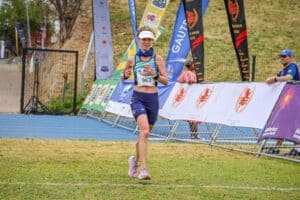"There are some who struggle through on a toxic mix of stubborn courage and dozens of pain killers but the price their health pays is not worth it."

Chondromalacia patella, Iliotibial-band friction syndrome, stress fracture, upper respiratory tract infection. This horrendous list of chronic conditions sums up the traps and mine-fields that await runners as they train intensely through this critical phase of their Comrades marathon preparation. They lurk like camouflaged aliens waiting to leap at dedicated runners, waiting to destroy inspiring running dreams.
And unfortunately, many runners are going to confront these vicious enemies, and other nasty allies of theirs, in the next few weeks. Sadly, many runners will become injured or sick in this very critical training time.
We know that statistically 65% of those runners who will not reach the Comrades marathon finish line at Moses Mabhida Stadium on 28 August will fail because they will be harbouring an injury or illness.
The Comrades is tough enough for a strong, healthy runner. It is almost impossible for a runner with a handicap. There are some who struggle through on a toxic mix of stubborn courage and dozens of pain killers but the price their health pays is not worth it.
I have a good running friend, who shall remain nameless, who earned his medal thanks to handfuls of anti-inflammatories. The price he paid for that medal was five nights in a Durban hospital recovering from kidney failure.
ALSO READ: Because it’s a Down run, we go Up
ALSO READ: Why the long run is so important
ALSO READ: A bridge too far?
ALSO READ: Do what I say, not what I do
ALSO READ: Key ingredients of a successful training programme
In mid-July the Comrades runner is like a tightrope walker wobbling erratically while balancing precariously between extreme fitness and complete disaster. I used to joke with my running companions that if a sparrow with a heavy cold sneezed in a tree a kilometre away from me I would be bedridden with flu two days later. That’s how hazardous this time can be.
However, it is how each runner responds to the occasional major wobble that determines success or failure at the Comrades.
We don’t have these statistics, but I would hazard a guess that more than 90% of the runners leaving the Pietermaritzburg starting line on race morning will have fought some problem or other in the weeks before Comrades.
How do runners fight back against the lurking enemy? A first defence is to understand that caution is the best form of attack. Don’t try anything new and untested.
Comrades 1984 race
In the weeks before the 1984 race I threw caution to the wind when I started vigorous gym work. I began lifting weights with my legs and arms. Perhaps the hamstring curls I attempted were too heavy, or perhaps my semi-squats with weights were too vigorous, but soon I developed a slight niggle in my right hamstring. I ignored the troublesome hamstring convincing myself that it was “just a minor twinge and would soon disappear.”
This is one of our sport’s most frequently cited excuses runners use for pushing on and ignoring common sense. “It’s just a little niggle. I’ll run it out.” It wasn’t, and I didn’t.
The cautious approach also advises against sudden increases in training mileage. And yet so many runners ignore that wise advice. Perhaps they are driven by an impending sense of destiny and the rapidly approaching race date. But they also throw caution to the wind as they argue.
“I have to double my mileage. I must make up for lost ground. I’ve lost two weeks of training.”
Runners have to recognise that what is gone is gone. Forget the missed training. Leave it behind, move on.
No perfect build-up
Do not ignore worrying symptoms or niggles no matter how trivial. That slight twinge in the hamstring could become a serious tear, as it did in my case, that scratchy throat could become a raging cold or infection.
Take comfort from the knowledge that even the champions and elite runners will have struggled with their own setbacks in the weeks before Comrades. Yes, even Gerda Steyn and Bongmusa Mthembu will have experienced minor injuries and illnesses that cost them some training days. No one has a perfect build-up.
I understand that it can be very depressing watching others running, while learning on social media about the prodigious distances others are logging in their training diaries, particularly when all you can do is clamp a bag of ice onto an inflamed ankle.
Take comfort also from the knowledge that injuries are often a “blessing in disguise”. They can act as “calming pills” or the valiums for over enthusiasm.
Comrades 1979 race
I recall 1979 Comrades champion Piet Vorster confiding in me that he didn’t rate his chances very highly in that year’s race. He had struggled for weeks with a bad ankle injury and had been unable to train. He was convinced that he would have to bail (drop out of) the race at some stage because he had not run sufficient mileage in training.
Not only did he not bail, but he won the race and in a new record time. At 80 kilometres he raced powerfully up and over Polly Shortts and was untouchable that day. I know. I was chasing Piet and was unable to catch him.
Rest assured that if you respond wisely and cautiously to a setback it will be a distant memory on race day. When you first set eyes on the amazing “1 kilometre to go” board you won’t remember the lost training, the cold you fought in July, or the injury that cost you five days training.






